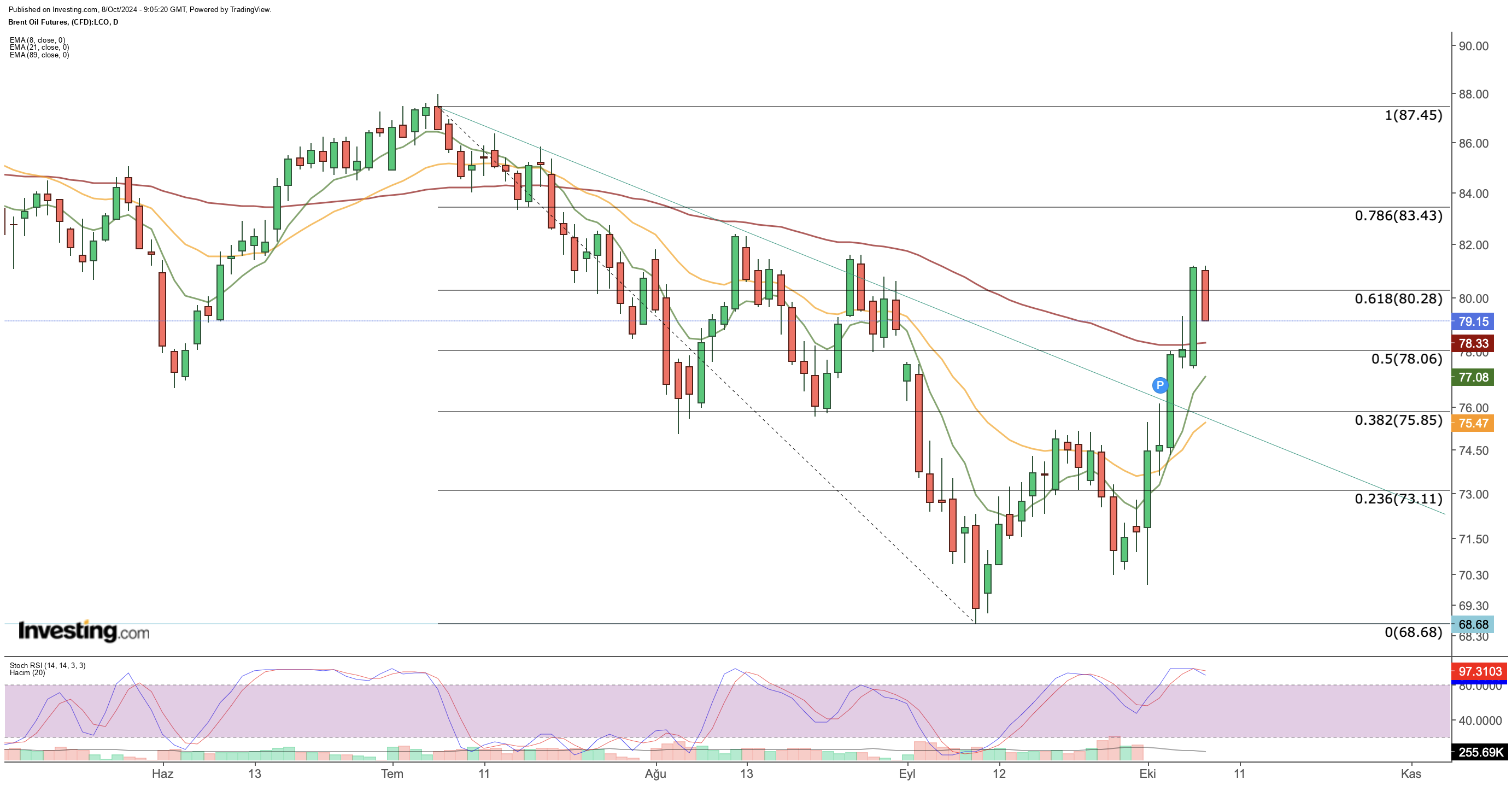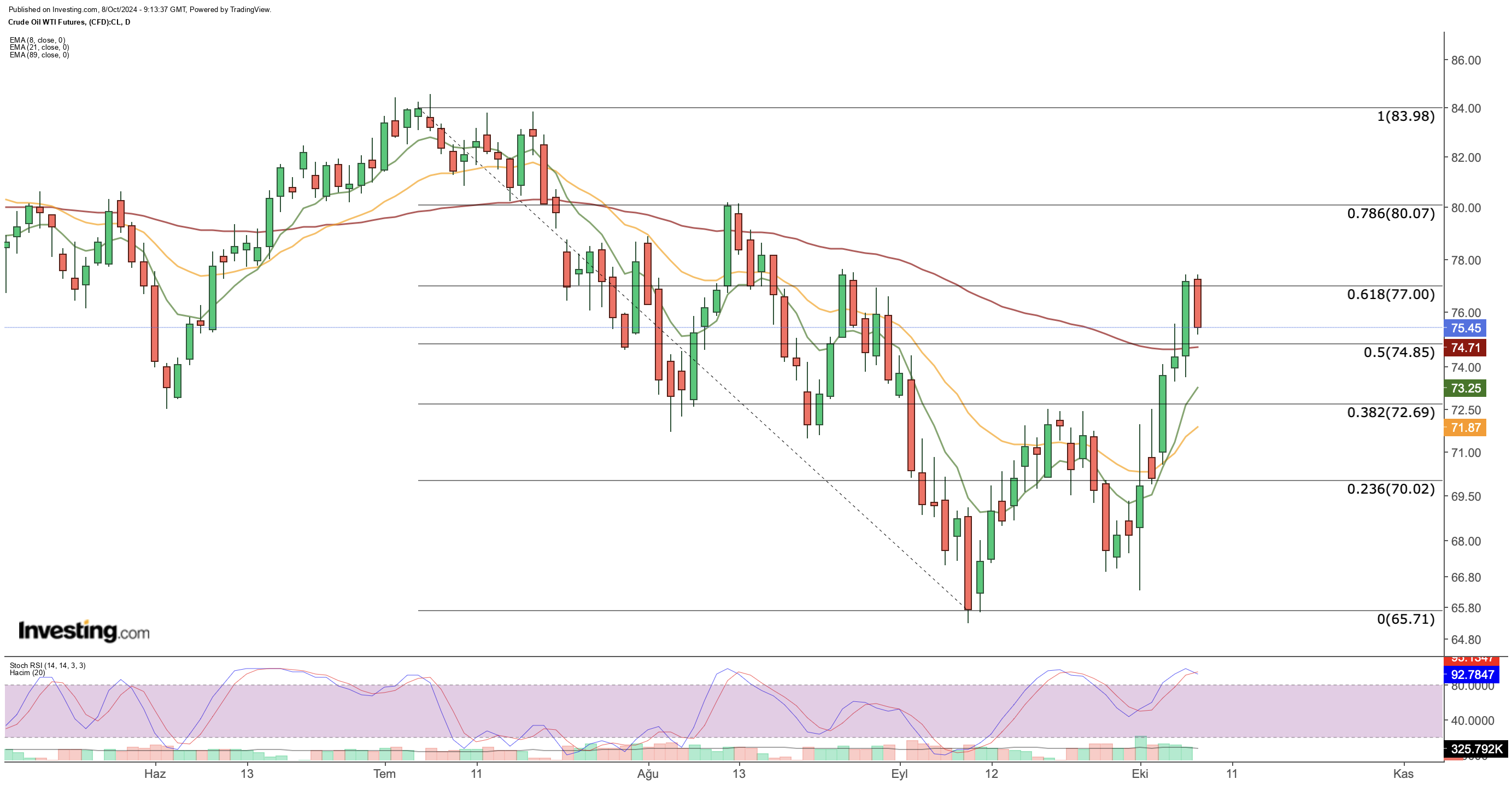TSX lower as gold rally takes a breather
- A potential strike on Iran's oilfields amid escalating Middle East tensions sparked a rally in oil before profit-taking ensued.
- Meanwhile, OPEC+ cuts also weigh on supply-demand dynamics.
- Key technical levels to watch include $80 resistance for Brent and $77 for WTI.
- Looking for actionable trade ideas to navigate the current market volatility? Unlock access to InvestingPro’s AI-selected stock winners for under $9 a month!
Escalating tensions in the Middle East are sending shockwaves through crude oil markets, overshadowing the typical pricing influenced by global supply and demand dynamics.
As tensions between Israel and Iran intensify, fears of a wider regional conflict loom large, prompting market participants to closely monitor developments in the region.
Recent missile attacks from Iran have heightened concerns about potential retaliation targeting Iran’s critical oil infrastructure, directly impacting oil prices.
Yesterday, Brent crude surged by 3.8%, peaking at $81.17 before a pullback today, marking a remarkable 13% increase over the past week.
Similarly, WTI crude futures climbed to $78.76 early in the day. This rapid ascent represents the highest weekly gain since March 2023, with prices now mirroring levels seen in August.
Markets Keenly Watching New Developments
The immediate spike in crude oil prices stems from Iran's missile attacks and the anticipation of a strike on Iranian oil fields.
Given Iran's significant role in the global oil supply—boasting an export capacity of 1.7 million barrels per day—the prospect of an attack raises serious concerns about potential disruptions in oil availability worldwide.
In a bid to stabilize the situation, President Biden has urged caution, promising incentives to Israel contingent on avoiding attacks on Iranian oil infrastructure.
While this has temporarily calmed markets, uncertainty still reigns, leaving traders on edge about potential volatility in the short term.
Supply-Demand Dynamics and OPEC's Role
Alongside geopolitical tensions, the crude oil market also grapples with supply-demand imbalances.
OPEC+ recently reduced production in response to weak global demand, but rapidly rising oil prices could force the coalition to reassess its output strategies.
Experts suggest that Brent crude needs to approach the $90 mark before OPEC+ considers increasing supply again.
Why Are Crude Oil Prices Correcting?
Beyond geopolitical risks, global economic conditions exert downward pressure on oil prices. China, the world’s largest oil importer, has faced economic sluggishness, contributing to declining demand.
Despite the Chinese government announcing stimulus measures, uncertainty lingers regarding their effectiveness in revitalizing growth.
Following last week's sharp price increase, the absence of new developments in the Middle East has led to a modest decline in crude prices today, with Brent and WTI retracting by about 2%—a potential signal of profit-taking.
However, renewed tensions could quickly reverse this trend.
Another factor in the recent price surge appears to be hedge fund activities. The closing of short positions, prompted by fears of supply disruptions in the Middle East, has likely accelerated price increases.
In summary, the crude oil market remains highly susceptible to geopolitical developments, particularly those originating in the Middle East.
The threat to Iran’s oil fields keeps prices elevated, while traders also keep a close eye on China’s oil demand and its implications for future pricing.
Ongoing economic weakness in China, combined with the potential for OPEC+ to adjust its production capacity, may alleviate some of the upward pressure on prices in the near future.
WTI, Brent: Current Support and Resistance Levels to Watch
From a technical perspective, Brent futures have encountered a significant resistance point during their recent rebound from July to September.

The $80 range is crucial, with the recent price action testing the fib 0.618 resistance level. If prices close above $80 for the week, we may see upward movement toward $83 and potentially $87.
Conversely, easing tensions could lead to a downward adjustment, with $78 emerging as a primary support level. A breach below this point could open the door for a further decline toward $75.

For WTI futures, the critical resistance level to watch is $77. If prices break through this barrier, targets of $80 and $84 may come into play.
On the downside, keep an eye on approximately $74.8 as the first support level, with potential declines to the $70-$72 range if daily closes fall below this level.
***
Disclaimer: This article is written for informational purposes only. It is not intended to encourage the purchase of assets in any way, nor does it constitute a solicitation, offer, recommendation or suggestion to invest. I would like to remind you that all assets are evaluated from multiple perspectives and are highly risky, so any investment decision and the associated risk belongs to the investor. We also do not provide any investment advisory services.
